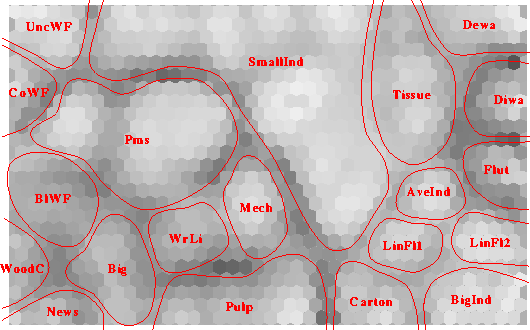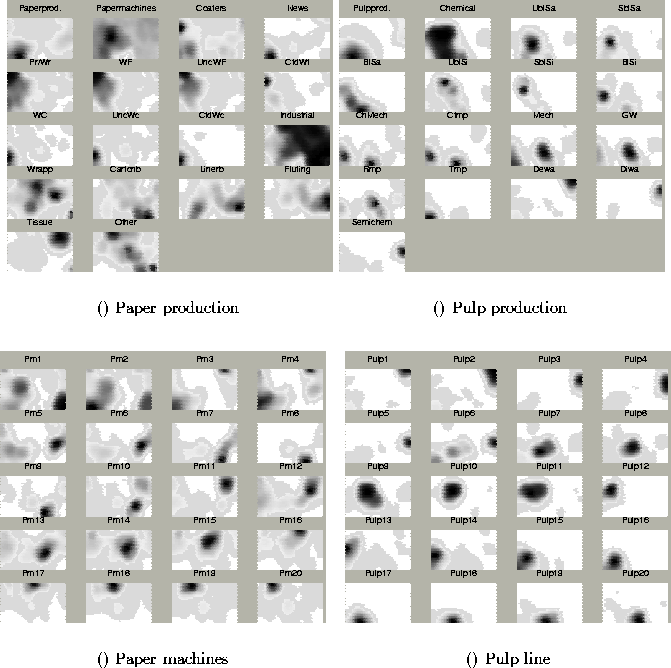The mill data set consisted of the total pulp and paper production
capacities, the number of paper machines, the number of coaters and
the percentage of total production of different pulp and paper types
for each mill. The components are presented in
table 5.5. They were augmented by the data histograms
from the paper machine and pulp line maps. For each mill the two data
histograms were constructed using the paper machines and pulp lines in
that particular mill. To emphasize the importance of high capacity
the histograms were weighted by the production capacities of the
machines/lines. After this the histograms were smoothed by convoluting
them with a symmetric vector
[0.3, 1, 0.3]![]() .
Finally the histograms were normalized.
.
Finally the histograms were normalized.

Figure 5.4: On the left side three different histograms 1,2 and 3.
Since in the SOM similar vectors are projected to close
lying map units, the histograms 1 and 2 should be more similar
than histograms 1 and 3. However, using euclidian distance
between histograms this is not so. Instead the quantization errors
(QE) are equal. This is corrected by convoluting the
histograms with a symmetric matrix as seen on the right side.
All in all the technology data set consisted of 4205 75-dimensional
vectors each corresponding to one mill. A 40x25-sized SOM was trained
with this data. The quantization error for the map was ![]() , topological quantization error
, topological quantization error ![]() and the
topographic error
and the
topographic error ![]() .
.
The u-matrix of the mill-technology map is shown in figure 5.5 and the component planes in figure 5.6. Several correlations between components can be seen from the component plane representation, such as that the mills with high paper production capacity usually also have a high pulp production and that newsprint production corresponded to high thermomechanical pulp production. Of special interest are correlations between different pulp and paper types and the distribution of values in the components corresponding to the low level maps (pm1-20, pulp1-20). From figure 5.6 it can also be seen that for some components the high values were divided between clearly different types of mills. For example there are two types of mills that produce chemimechanical pulp: those that also produce wood containing paper and those that concentrate purely on producing pulp.
An analysis of mill-types was performed by first dividing the map into 31 initial clusters. After this all components were separated to three ranges and it was investigated which clusters had component values in the two highest thirds. Finally each cluster was examined to see what kind of mill-type it corresponded to. During this procedure some of the initial clusters were combined. For example the SMALLIND cluster was combined from several initial clusters corresponding to mills producing various industrial papers. The only truely separating factor between the initial clusters was that they received data from different units of the paper machine map: units 13 - 20 corresponding to old and small paper machines. The cluster analysis resulted in the 20 different mill-types described in table 5.6.
A couple of important notices are in place here. Firstly, the set of 20 mill-types is by no means definitive. Depending on the desired precision also several other clusters could be extracted from the map. For example the PULP cluster can be divided into three subtypes based on the pulp type and the production capacity. Secondly, the clustering is heavily influenced by the choice and scaling of the components. The mill-types achieved in this study reflect only the information present in the used data components. By changing part of the components, or even scaling them differently, a different set of mill-types could be achieved. Thirdly, the analysis made so far details the different clusters only in very sketchy terms. To get a better view of the different types, performing a more detailed in-cluster or in-type analysis would be beneficial.

Figure: The u-matrix of the mill-technology map.
Black corresponds to high value of the u-matrix, white
to small value. The mill types have been marked on the
map with red lines and labeled as in table 5.6.
| Component | value range | M.D. | |
| Paper production ( | 0 - 1260 | 79 | 40 |
| Paper machines | 0 - 15 | 1.2 | 1 |
| Coaters | 0 - 12 | 0.48 | 0.4 |
| Newsprint % | 0 - 100 | 6.7 | 4 |
| Print/write paper % | 0 - 100 | 32 | 10 |
| Woodfree (WF) paper % | 0 - 100 | 29 | 10 |
| Uncoated WF paper % | 0 - 100 | 24 | 10 |
| Coated WF paper % | 0 - 100 | 6.7 | 4 |
| Wood containing (WoodC) paper % | 0 - 100 | 6.0 | 3 |
| Uncoated WoodC paper % | 0 - 100 | 4.0 | 3 |
| Coated WoodC paper % | 0 - 100 | 2.2 | 2 |
| Industial papers % | 0 - 100 | 20 | 20 |
| Wrapping paper % | 0 - 100 | 21 | 20 |
| Cartonboard % | 0 - 100 | 22 | 20 |
| Linerboard % | 0 - 100 | 15 | 10 |
| Fluting % | 0 - 100 | 14 | 10 |
| Tissue % | 0 - 100 | 20 | 10 |
| Other papers % | 0 - 100 | 17 | 10 |
|
Pulp production ( | 0 - 1075 | 77 | 20 |
| Chemical pulp % | 0 - 100 | 34 | 7 |
| Unbleached sulphate (Sa) % | 0 - 100 | 9.2 | 5 |
| Semibleached Sa % | 0 - 100 | 0.59 | 0.5 |
| Bleached Sa % | 0 - 100 | 12 | 6 |
| Unbl. sulphite (Si) % | 0 - 100 | 1.5 | 1 |
| Semibl. Si % | 0 - 100 | 0.076 | 0.7 |
| Bleached Si % | 0 - 100 | 2.2 | 2 |
| Chemimechanical pulp % | 0 - 100 | 2.4 | 2 |
| Chemi-thermomechanical pulp (CTmp) % | 0 - 100 | 1.6 | 1 |
| Mechanical pulp % | 0 - 100 | 13 | 5 |
| Groundwood % | 0 - 100 | 9.8 | 5 |
| Refiner mechanical pulp (Rmp) % | 0 - 100 | 0.65 | 0.6 |
| Thermomechanical pulp (Tmp) % | 0 - 100 | 2.7 | 1 |
| Deinked waste paper (Dewa) % | 0 - 100 | 14 | 3 |
| Disperged waste paper (Diwa) % | 0 - 100 | 4.9 | 2 |
| Semichemical pulp % | 0 - 100 | 4.2 | 2 |

Figure 5.6: The paper production (a), pulp production (b), paper machines (c) and pulp lines (d) related component planes of the mill-technology map.
For each component the black corresponds to the highest value and white to
the smallest.
| TYPE | Description |
| UNCWF | Uncoated woodfree paper, either new big machines or older and smaller. |
| SMALLIND | Various industrial papers, machines old and small. |
| TISSUE | Tissue paper, average wirelength and speed. |
| DEWA | Some tissue paper, but especially high deinked waste paper usage. |
| COWF | Many coaters, coated woodfree paper, machines of average capacity and speed. |
| PMS | Many paper machines including some high capacity paper machines, uncoated woodfree but also various industrial papers, unbleached and semibleached sulphite pulp. |
| DIWA | Cartonboard, linerboard and fluting papers, disperged waste paper for pulp. |
| BLWF | Uncoated woodfree paper, bleached chemical pulp from wood fibre. |
| BIG | High capacity, many machines and coaters, woodfree paper or linerboard, pulp is chemical (sulphate), machines are big. |
| WRLI | Wrapping paper and linerboard, unbleached sulphate pulp, big paper machines. |
| MECH | Various industrial papers, pulp is unbleached and mechanical: groundwood or rmp. |
| AVEIND | Cartonboard, linerboard and fluting paper, average capacity machines. |
| FLUT | Fluting paper, semichemical unbleached pulp, average capacity paper machines. |
| WOODC | Wood containing paper, chemimechanical or mechanical pulp from wood fibre, average capacity paper machines. |
| NEWS | High paper capacity: newsprint, thermomechanical pulp, high capacity paper machines and pulp lines. |
| PULP | No paper production, but large pulp production, high capacity pulp lines, big market percentage. |
| CARTON | Cartonboard and other papers, big weight in paper machines. |
| LINFL1 | Linerboard and fluting paper, small to average sized machines. |
| LINFL2 | Linerboard and fluting paper, high capacity machines. |
| BIGIND | Cartonboard, wrapping, tissue and other papers, high capacity machines. |